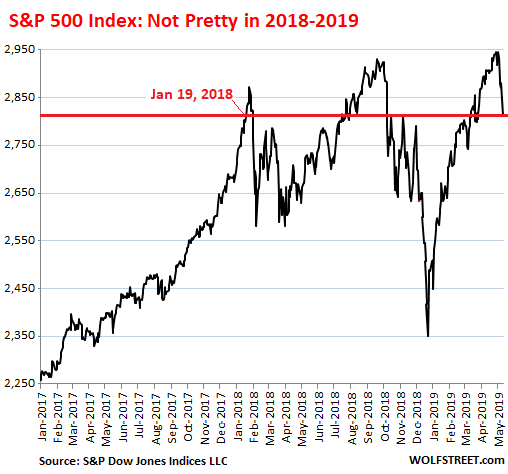Wolf Richter wolfstreet.com, http://www.amazon.com/author/wolfrichter
Russell 2000 back where it had first been in November 2017.
This market, after a historic rally despite declining corporate earnings in the first quarter, was looking for a trigger, any trigger, and it found a trigger, or triggers. But the trade war cannot explain the colossal flops in the over-hyped IPO realm.
The Nasdaq composite dropped 3.4% today. In the six trading days since its peak on May 3 (8,164), it has dropped 6.3%, after a historic surge of 32% from December 24 through May 3. I mean, what did you expect? The index is now back where it had first been on June 6, 2018.
Uber, which had sold its China operations and is no longer significantly tangled up in the US-China trade war, is morphing from the biggest, most hyped tech IPO in recent memory into the most colossal flop in recent memory. Shares plunged nearly 11% today to $37.10 a share. This left shares down 17.6% from its IPO price of $45, at which Uber had extracted another $8.1 billion from gullible investors.
Prior investors are even deeper in the hole. Uber extracted nearly $7 billion from institutional investors between December 2015 and February 2017 by selling them 140 million shares at $48.77 a share, over half of them to Saudi Arabia’s Public Investment Fund, and these folks are now down nearly 24%. Shares of Softbank, which also holds a large stake in Uber, fell 5.5% today.
Lyft dropped another 5.7% today, to a new closing low of $48.15. Lyft had been the trailblazer this year for the hottest most hyped IPOs.
On March 28, Lyft priced the IPO shares at $72 and extracted at this price about $2.3 billion in new money from IPO investors. On March 29, the first day of trading, it took hours of machinations before shares finally started trading, with a heavily mediatized “pop” of 21%, at $87.24. Then, Lyft shares plunged 10% in 4 Hours from “pop” to close. Today, shares were down 45% from the pop.
Both Lyft and Uber have no idea if, when, or how they’re ever going to reach a self-sustaining business model that doesn’t burn large amounts of investor cash every year. Now, since their IPO, they’re loaded up with cash to burn and can fuel their cash-burn machines for a little while.
Speaking of which…. Tesla extracted another $2.7 billion from investors last week via a share and convertible note offering to fuel its cash-burn machine. Its shares fell 5.2% today to $227.01, down 41% from its peak in June 2017. Giddy Tesla investors had first seen this share price of $227 in June 2014. Oh my, how time flies when you’re having fun.
Apple – unlike the hapless rideshare companies in search of a business model – is deeply tangled up in China with its supply chain and with its revenues. It’s also deeply tangled up in other issues, including iPhone sales that have gotten battered by competition in a stagnating smartphone market. It didn’t help that Apple got hit by a US Supreme Court opinion today that allows consumer plaintiffs to move forward with their antitrust lawsuit.
So Apple shares fell 5.8% today to $185.72, which leaves them down 20.5% from their high on October 3, 2018
Intel fell another 3.1% today, to $44.76, bringing its plunge since its peak on April 22, 2019, to 26%. Global semiconductors sales are now in the steepest plunge since the Financial Crisis.
The Dow Jones Industrial Average fell 2.4% to 25,324, a level first visited on January 9, 2018. In other words, the index spent 16 months going nowhere despite hair-raising volatility that caused a 19% peak-to-trough plunge, followed by a blistering 22% rally in just four months. It’s now about 5% below its October 2018 peak.
The S&P 500 index dropped 2.4%, is down 4.5% over the past six trading days, and is back where it had first been on January 19, 2018. Like the Dow, it spent 16 months going nowhere despite violent ups and downs. Unlike the Dow and the small-cap Russell 2000, the S&P 500 did eke out a new closing high on April 30 and May 3, but barely, and the 4.5% drop since then is staring to not look very pretty on the chart (data via S&P Dow Jones Indices):

The Russell 2000 index, which covers stocks with smaller market capitalizations, fell 3.2% today, to 1,523. It has now dropped 12.5% from its October 2018 peak (1,741) and is back where it had first been on November 19, 2017, a very volatile 18 months of going nowhere.